Russian scientists hope to 'bring back' 50,000-year-old cave lion in Jurassic Park-style experiment
Cub from extinct specie was found 'perfectly preserved' in freezing conditions in Siberia

Your support helps us to tell the story
From reproductive rights to climate change to Big Tech, The Independent is on the ground when the story is developing. Whether it's investigating the financials of Elon Musk's pro-Trump PAC or producing our latest documentary, 'The A Word', which shines a light on the American women fighting for reproductive rights, we know how important it is to parse out the facts from the messaging.
At such a critical moment in US history, we need reporters on the ground. Your donation allows us to keep sending journalists to speak to both sides of the story.
The Independent is trusted by Americans across the entire political spectrum. And unlike many other quality news outlets, we choose not to lock Americans out of our reporting and analysis with paywalls. We believe quality journalism should be available to everyone, paid for by those who can afford it.
Your support makes all the difference.The discovery of an extinct cave lion cub from the Ice Age has raised hopes that it could be cloned and its species brought back to life some 50,000 years after it disappeared.
The tiny animal was found “perfectly preserved” with its paw resting on its head on the bank of Tirekhtykh River in the Abyisky district of Yakutia in Siberia in Russia.
Investigators says the small creature was about eight weeks old but cannot say how it died in the area that is permanently frozen – in conditions that helped keep its remains from decaying.
Cave lions were native to regions in the northern hemisphere before they became extinct, and the only knowledge of the animals that hunted in packs is from cave paintings left by early man.
Dr Albert Protopopov, of the Academy of Sciences of the Republic of Sakha, in Yakutia, unveiled the discovery.
“It is a perfectly preserved lion cub, all the limbs have survived. There are no traces of external injuries on the skin,” he told The Siberian Times.
“The preservation is so good that it raises hopes of cloning the species back to life," he added.
Tests so far have found that the cub is 45 centimetres long and weighed almost 9lbs. It is not known whether it is male of female because newborn lions do not have noticeable sex characteristics.
Studies of its teeth are underway to find out its exact age – but could take up to three years.
Siberian resident Boris Berezhnov discovered the remains of the “unrecognisable animal” when the level of the Tirekhtykh River dropped to reveal the carcass lying on the bank of the water.
It comes after a similar discovery of two newborn cave lion cubs – named Uyan and Dina – found in the same region in 2015. Research found they were up to 55,000 years old.
“Everyone was amazed then and did not believe that such a thing is possible, and now, two years later, another cave lion has been found in the Abyiski district,” Dr Protopopov said.
“The preservation degree is even better,” he added.
One of the two cubs was found with its mother’s milk in its remains and scientists are hoping that by analysing it they can determine the diet of the adult creatures.
They hope that could shed light on how cave lions became extinct if they discover, for example, that a particular animal it preyed upon itself disappeared from the planet around the same time.
Join our commenting forum
Join thought-provoking conversations, follow other Independent readers and see their replies
15Comments